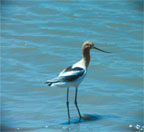|

|
Kids experience the
fun of body boarding in the surf of the
Sanctuary. (photo: Gulf of the Farallones
NMS)
|
|

|
An american avocet
poses in the view of a birdwatcher's
spotting scope. Birdwatching opportunities
abound in the Sanctuary. (photo: Gulf of
the Farallones NMS)
|
|

|
A humpback whale
surfaces near a whale watch boat, much to
the delight of the onlookers. (photo: Gulf
of the Farallones NMS)
|
|

|
Discovering
treasures in the tidepools at Fitzgerald
Marine Reserve in Moss Beach. (photo: Joe
Heath)
|
|

|
Kayaking the Estero
de San Antonio is a rare opportunity for
accessing one of the most remote reaches
of the Sanctuary. (photo: Maria
Brown)
|
|

|
A recreational
fisherman surveys his catch of halibut in
Tomales Bay (photo: Gulf of the Farallones
NMS)
|
|

|
Sailing the wild
waters beyond the Golden Gate. (photo:
Gulf of the Farallones NMS)
|
|

|
An urchin diver
braves the shark-infested waters around
the Farallon Islands to harvest the bounty
in the baskets to his left. (photo: Karina
Racz)
|
|

|
The seasonal catch
of herring in Tomales Bay (photo: Richard
Allen)
|
|

|
Ship traffic abounds
at the entrance to San Francisco Bay, with
vessels passing through the Sanctuaries
beyond the Golden Gate. (photo: Gulf of
the Farallones NMS)
|
|

|
Fishermen stand in
the surf at Ocean Beach in San Francisco
to bring home the bounty. (photo: Gulf of
the Farallones NMS)
|
|

|
The Gulf of the
Farallones has over 100 dedicated
volunteers for the Beach Watch program.
Beach Watch volnteers survey their
designated sanctuary beaches once a month,
and receive 80 hours of classroom and
field training. (photo: Gulf of the
Farallones NMS)
|
|

|
A beach volunteer
records the numbers and species of birds
present at his designated beach watch.
(photo: Gulf of the Farallones
NMS)
|
|

|
Beach Watch
volunteers document the live and dead
animals of the Sanctuary. (photo: Gulf of
the Farallones NMS)
|
|

|
Volunteers for the
SEALS program conduct research and
interpretation on the harbor seals of the
Gulf of the Farallones National Marine
Sanctuary. SEALS volunteers are provided
with extensive field and classroom
training as part of the program. (photo:
Jan Roletto)
|
|

|
Haul out sites, like
this one on Tomales Bay, are critical to
harbor seals' rest and reproductive
success. (photo: Mike Falzone)
|

|
Thanks to the SEALS
program, both clammers and seals can share
the sand bars at low tide. (photo: Maria
Brown)
|
|

|
Biologists from US
Fish and Wildlife work to reestablish a
colony of Common Murres in a nearshore
area of the Sanctuary. This colony of
Murres was wiped out by an oil spill but
recovery efforts are showing positive
results. (photo: Mike
Parker)
|
|

|
Sanctuary staff and
scientists routinely survey rocky
intertidal sites on the Farallones to keep
track of the health of the Sanctuary from
its most accessible points. (photo: Gulf
of the Farallones NMS)
|
|

|
Scientists tow a
manta net to get a sample of organisms at
the surface of the Sanctuary. (photo:
Jamie Hall)
|
|

|
Kids' activities and
special events and programs help to bring
the Sanctuary to the public. (photo: Sandy
Howard)
|
|

|
Curious kids and
adults peer through the microscope exhibit
in the Gulf of the Farallones National
Marine Sanctuary Visitor Center in San
Francisco while grasping the importance of
Sanctuary science. (photo: Karina
Racz)
|
|

|
Interpretive
programs like nature walks guide visitors
in discovering more of the wonders of the
Sanctuary. (photo: Maria Brown)
|





